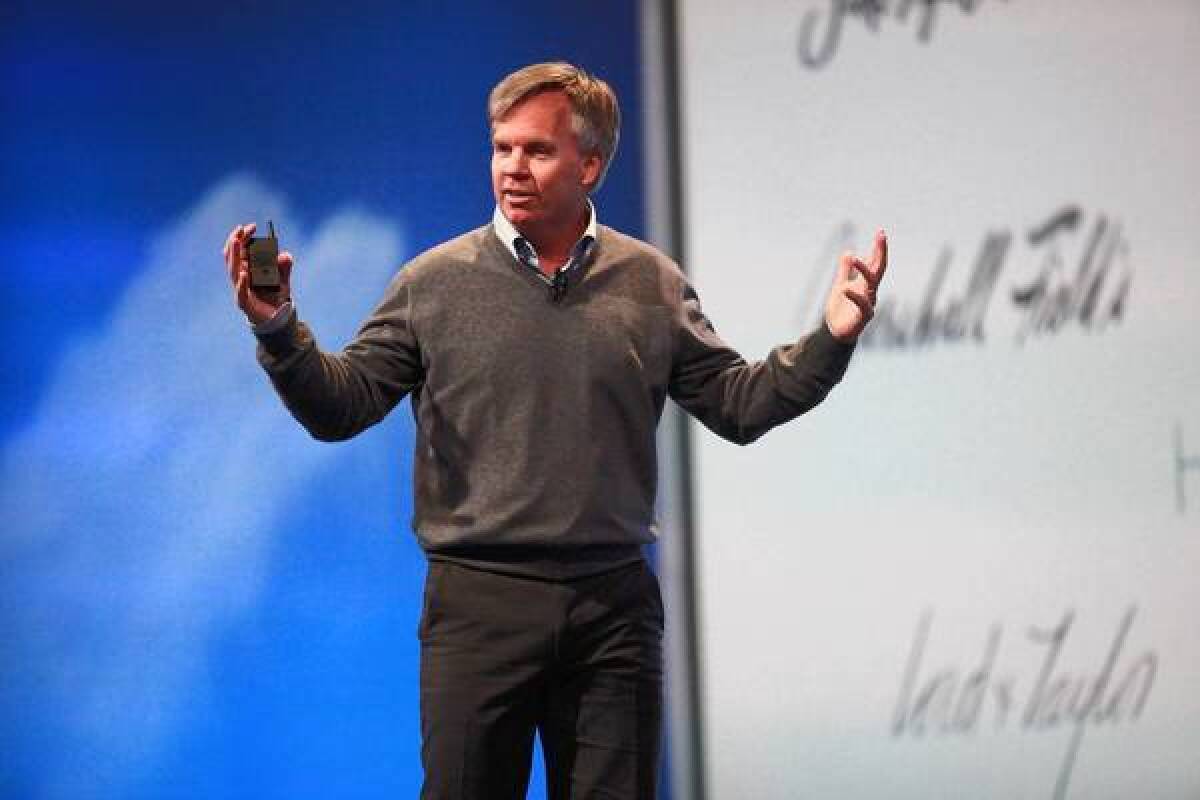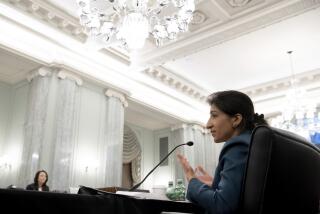CEO-to-worker pay gap is obscene; want to know how obscene?

- Share via
Nothing seems to get U.S. corporations’ dander up like a threat to the pay and perks of their chief executives.
That’s one explanation for corporate America’s superheated, turbocharged, over-the-top reaction to the CEO pay ratio rule recently proposed by the Securities and Exchange Commission.
The rule requires most large public companies to calculate the ratio of the pay of their chief executive officer to the median pay of all their employees. Its general terms were mandated by the Dodd-Frank Act, which imposed numerous regulatory changes on corporate and banking behavior in the wake of the 2008 financial meltdown.
Congress, however, asked the SEC to figure out how to put it into practice. The SEC voted in September to open its proposed version to comments from supporters and opponents for 60 days. Whatever it finally approves won’t go into effect until 2015.
Wall Street, big banks and corporate lobbying groups have mustered their troops to fight the most important Dodd-Frank provisions. But the opposition to the CEO rule has a different flavor entirely. It’s not unusual for the business community to claim that a new regulation will spell the end of industry. In this case, they’re arguing that it will threaten the SEC too.
It’s not hard to see why. Unlike most SEC regulations, the CEO rule isn’t really designed to provide information for investors. Rather, it’s designed to provide information for the larger community — for society, if you will. Its aim is to provide ammunition for the argument that the share of corporate profits going to top management, and by extension corporate shareholders, has gotten out of control.
That’s a sound argument, shared by many management experts and economists who argue that the diversion of corporate resources from workers to executives and shareholders is a major contributor to rising income inequality in the U.S., as well as to other social and economic ills.
For example, British economist Andrew Smithers observes in his new book, “The Road to Recovery,” that stock-related bonuses for executives encourage them to make decisions that boost their share prices in the short term, rather than in the long term. The harvest is that they spend corporate capital less on long-term investments, which will set their companies up for future profit, and more on shoveling dividends to investors, which props up their shares quarter by quarter.
That isn’t a novel insight by any means, but Smithers’ figures are eye-opening. In the 1970s, he observes, American companies devoted 15 times as much capital to investments as they disbursed to shareholders. Today the ratio is less than 2 to 1.
It’s also not a new finding that outsized CEO compensation depresses employee morale, especially among middle managers. The great management guru Peter Drucker advised companies to stick to a ratio of about 20 to 1 between the pay of the CEO and that of the average worker. That’s “the limit beyond which they cannot go if they don’t want resentment and falling morale to hit their companies,” Drucker wrote, according to a comment on the CEO pay rule submitted to the SEC by Rick Wartzman, executive director of the Drucker Institute at Claremont Graduate University.
Drucker’s standard was in line with the ratios of the 1970s and early ‘80s, when he wrote those words. Today they seem positively quaint. The average CEO-to-worker pay ratio in 2012 was about 350 to 1. That’s down somewhat from where it was before the 2008 recession, but it would have to come down a great deal more to return to the non-obscene range.
It’s plain that this ratio typically has little to do with an executive’s performance. The CEO-to-average-worker pay ratio of the 250 largest companies in the Standard & Poor’s 500 index ranges from 1,795 to 1 (J.C. Penney’s Ron Johnson) to 173 to 1 (Agilent Technologies’ William Sullivan), according to Bloomberg, which ran the data for 2012.
Do those figures reflect the two CEOs’ relative value to their companies? Well, no. Agilent shares have risen 49% over the last year, while J.C. Penney’s have fallen 73%. Johnson’s compensation was the product of his November 2011 recruitment by the Penney board, which expected him to work the same magic on the stumbling department store chain that he had at Apple, where he created the fabulously successful Apple Stores. But he was terrible at Penney, and within 17 months he was gone.
The thrust of the business community’s attack on the CEO rule is its supposed complexity and cost. The Center on Executive Compensation, a corporate think tank, groused this summer that it’s inflexible and “unjustifiably complex.” The rule requires companies to calculate the median pay of all employees — that is, the level at which half are paid more and half less — rather than just a simple mean average, which would be easier. Other critics say it will make companies with lots of overseas workers earning Third World wages look especially bad.
Yet these fears may be unfounded. The rule under consideration by the SEC allows companies lots of flexibility in choosing how to calculate median compensation. And they would have more than a year to do so.
It may be true, as some critics say, that the rule doesn’t tell investors anything useful — or more precisely, it doesn’t tell them anything they don’t already know. The salaries of top executives already must be disclosed annually; it doesn’t take an advanced computer algorithm for investors in, say, JPMorgan Chase to know that Chairman and CEO Jamie Dimon is compensated immensely well ($62.6 million over the last three years).
But it doesn’t follow that serving investors should be the limit of the SEC’s mandate. Congress thinks that corporate disclosures also can serve a social purpose. Why saddle the SEC with the job of overseeing these rules? It’s because the SEC is the only agency with the legal power to mandate corporate disclosures; Congress is simply putting this preexisting authority to use. Nor is this the first time that’s happened. As far back as the 1970s, the SEC was ordered to force companies to make environmental disclosures.
But that may be what irks Big Business the most about the CEO pay ratio rule. As Meredith Cross, a corporate lawyer who has walked through the revolving door between the SEC and business world at least four times in her career (two stints at the agency’s division of corporate finance, two at the law firm WilmerHale), observed in a recent speech, “requiring companies to post potentially embarrassing information … can be a very powerful motivator to change corporate behavior.... There is a significant risk that people will keep pushing for it.”
Mary Jo White, the new SEC chair, is also uneasy about “social” disclosures. In a speech this month, she acknowledged concerns that the SEC’s independence could be compromised “by those who seek to effectuate social policy or political change through the SEC’s powers of mandatory disclosure.” Those concerns about social agendas, she said, “resonate with me.”
But she did vote with the 3-2 majority in September to open the CEO pay rule to public comment.
What corporate managements may not want to admit is that the CEO pay rule may help investors after all. Just as investors have a legitimate interest in whether their companies are big polluters, there’s reason to think the ratio of CEO pay to average compensation really is meaningful, as Drucker perceived.
You get some information from reading that Ron Johnson’s 2011 compensation at J.C. Penney was $53 million, and rather more from learning that it was 1,795 times the average Penney worker’s pay. For one thing, the second figure should underscore that a board that pays an incoming CEO that much may be out to lunch. Smart investors try to find out everything they can about a company, so what’s the argument for leaving this nugget out?
But the value of the ratio does truly lie in what it tells the community. It’s typically CEOs and their acolytes who argue that there’s nothing wrong with their pay scale. But it is wrong. It underscores the corrosive effect of income and wealth inequality in society at large. And when a trend builds toward a crisis, as this one is doing, the more society knows about it the better.
Michael Hiltzik’s column appears Sundays and Wednesdays. Read his new blog, “The Economy Hub,” at latimes.com/business/hiltzik, reach him at [email protected], check out facebook.com/hiltzik and follow @hiltzikm on Twitter.
More to Read
Inside the business of entertainment
The Wide Shot brings you news, analysis and insights on everything from streaming wars to production — and what it all means for the future.
You may occasionally receive promotional content from the Los Angeles Times.











